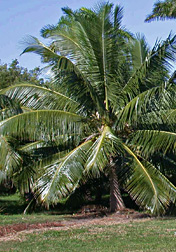This page has been archived and is being provided for reference purposes only. The page is no longer being updated, and therefore, links on the page may be invalid.
|
Read the magazine story to find out more. |
|
|
|
|
Fiji Dwarf Coconut is One Tough Nut
By Alfredo FloresMay 29, 2008
A coconut improvement program involving Agricultural Research Service (ARS) scientists in Miami, Fla., has focused on the very durable "Fiji Dwarf" variety to combat a shortage of coconut germplasm in the Florida landscape trade. Valued for their fruit and processing by-products, these trees are also in high demand as a signature landscape element.
But in the 1970s, the lethal yellowing (LY) phytoplasma began attacking the South Florida coconut canopy and had destroyed about 100,000 coconut palms by 1983. As a result, Florida's Division of Forestry initiated a coconut-breeding program at the ARS Subtropical Horticulture Research Station (SHRS) in Miami.
There, strategies for managing LY focused on replacing tall, disease-susceptible varieties with resistant, dwarf types. Although state funding for the LY breeding and disease-management program ended in the 1980s, the SHRS coconut germplasm collection was maintained and eventually incorporated into the National Plant Germplasm System.
ARS research geneticist Alan Meerow began to review the SHRS coconut germplasm after joining the staff in 1999. Fiji Dwarf (also known as Niu Leka) emerged as the prized jewel among varieties because of its heavy, dense crown of short, dark leaves—features especially sought by ornamental growers, landscapers and gardeners. Although it has variable LY resistance in Florida, it is free of nutritional deficiencies that plague most other coconut varieties grown on Florida's relatively infertile soils.
Since 2001, the SHRS researchers have been using molecular tools to investigate the genetics of Fiji Dwarf and other varieties. Meerow and horticulturalist Tomas Ayala-Silva want to know if it's possible to distinguish an LY-resistant Fiji Dwarf genotype.
So far, data show that Fiji Dwarf has the second-highest genetic diversity among coconut varieties, after the tall varieties such as the "Panama Tall," and the largest number of unique variations, or alleles, of any cultivar group within the study. In the past six years, not a single Fiji Dwarf has died of LY at the SHRS. ARS scientists suspect that the surviving Fiji Dwarf palms at their location may be resistant to LY. Meerow and Silva continue to work on this variety with the tropical landscape horticulture industry in mind.
Read more about the research in the May/June 2008 issue of Agricultural Research magazine.
ARS is the U.S. Department of Agriculture's chief scientific research agency.

